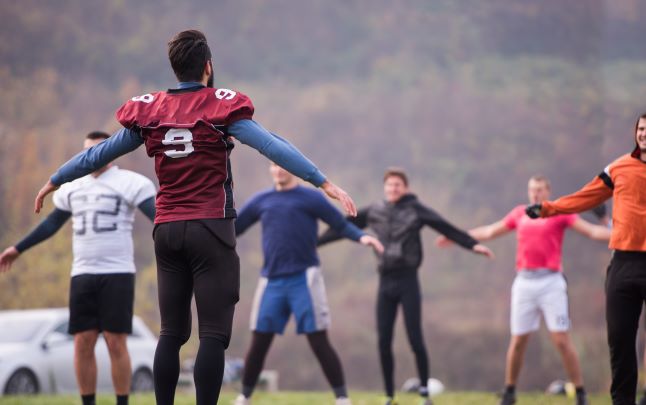Note that your final mark will not be saved in the system.
C2-C3 Adapting & delivering a warm-up for different participants and activities GapFill
You must fill all the gaps before clicking ‘Check Answers!’

There are many considerations that must be put into practice when delivering a warm-up to prepare participants for the main activity or sport. This covers the organisation and demonstration of activities, as well as the support given to participants as they take part.
Organisational aspects
The persons(s) that lead(s) a warm-up need(s) to firstly consider the organisation of participants. The bigger a group, the more that will be needed for participants. This will prevent participants from with each other and give them enough room to perform each of the activities.
The activities included in a warm-up will dictate requirements. For example, colour-coded cones might be used for a pulse raiser to inform participants of the speed at which they should be running (green for a light jog, yellow to transition to a run, and red to transition into a stride). Examples for other components may include resistance bands to perform stretches or to perform mobilisers while lying down.
Warm-up leaders will have to consider the of the different activities to ensure they complete all components within time. Warm-ups should not be too as participants are likely to get bored or may overwork themselves to the point of fatigue.
Demonstrations
Demonstrations help participants what is required from a given warm-up activity. Some activities that may seem self-explanatory, e.g. to walk, jog or run, may be perceived differently by different people. Also, the instructions should consider the type of participants involved in the warm-up. In particular, people with will benefit from demonstrations that may seem self-explanatory.
Another important aspect when giving demonstrations is positioning. The warm-up leader should be in full view of participants when giving demonstrations so everyone has a clear view of what is expected.
Supporting participants
Finally, warm-up leaders must support participants to guide them through the warm-up. This can be achieved through:
- participants - paying attention to participants will allow leader to give participants continuous feedback throughout each activity
- Providing - these should be given alongside demonstrations for each activity so that participants are clear on what is required. This is important as some participants respond best to auditory information.
- Providing - these are simple sentences that break down how an activity is performed to assist participants in performing it correctly. An example for a static stretch may be to 1) extend the muscle through its range of motion, 2) hold it in position for a short amount of time, and 3) step out of the stretch.
- Providing feedback - participants need to know whether they are performing activities correctly. Warm-up leaders should provide continuous feedback to inform them on how they are doing. There are many types of feedback, with two common types being feedback, which highlights things participants are doing well, and feedback, which informs participants of aspects they may be getting wrong. It is important that all types of feedback are constructive to maintain positivity when delivering a warm-up.